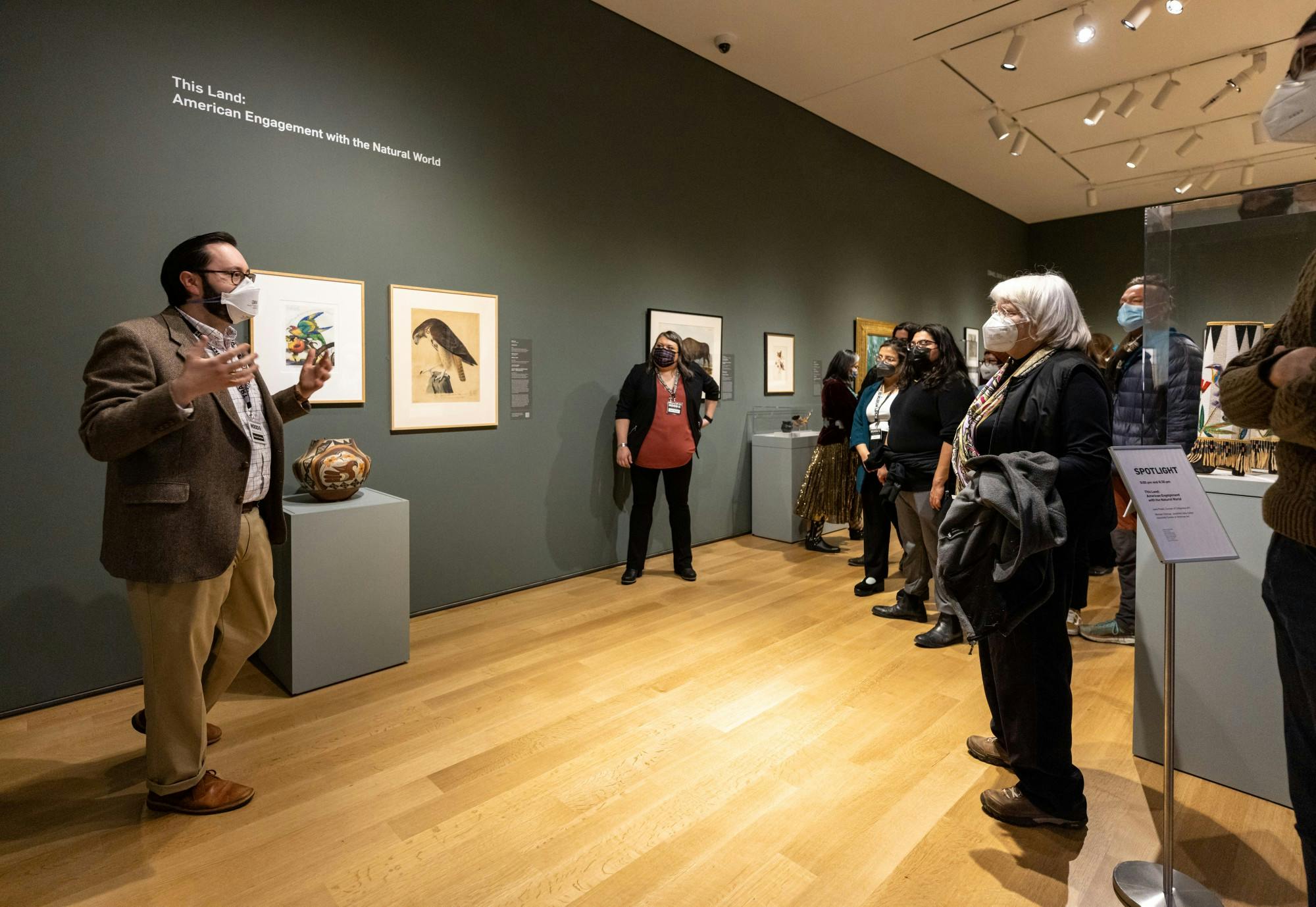Updated 11:06 a.m., April 12, 2022.
The Hood Museum of Art hosted “Convening: Re-Envisioning Histories of American Art” on April 7, which included three panel discussions about “This Land,” the Hood’s first exhibition to feature traditional and contemporary Native American works alongside the broader American art collection. This exhibit is focused on collecting art pieces that better represent diverse communities — both in the artists and in the subjects of the art — and restructuring the canon of American art.
Jami Powell, the Hood’s curator of Indigenous art and lecturer in the Native American studies department, curated the “This Land” exhibition with colleagues Barbara J. MacAdam, Thomas H. Price, Morgan E. Freeman and Michael Hartman. For the exhibition, Powell brought together the Hood’s American art collection with the Native American art collection.
“My colleagues and I applied for and received a $75,000 grant from the Terra Foundation for American art to host the 'Convening,' where we’re bringing scholars and curators, engaging in conversations about re-envisioning American art and how we are trying to make art history and museums more equitable and inclusive,” Powell said.
The event comprised of three panel conversations: “Complicating Histories: Curating Across Disciplinary Boundaries,” “Reframing Collection Practices and Care” and “Redefining ‘American’ Art Across Disciplinary Boundaries,” which considered definitions of American art, ethics in museum collections and the narrative power of Indigenous art. After the discussions, the panelists and curators spent the day workshopping the presentations for an eventual publication
“Out of this, we will produce a peer-reviewed scholarly publication rather than a typical catalog, which has a couple of essays and is heavy on exhibition,” Powell said. “We’ll be producing a book of ten to twelve essays, inspired by the present presentation’s trends.”
Ish McLaughlin ’22 and Parker Hershberger ’22, students in NAS 30.21: Native American Art and Material Culture, which is taught by Powell, attended the panel discussions. Mclaughlin noted the intersection between the course’s focus and the Hood's exploration of the erasure of Indigenous artists.
“I really like the course design because there is a lot of interaction with the Hood Museum,” McLaughlin said. “The fact that we’re talking about what American art is in the panels today shows just how important that interaction is.”
Michael Hartman, associate curator of American Art at the Hood, said he saw the panel discussions as a launching point for highlighting Indigenous art.
“One of my favorite moments in the exhibition is the side-by-side of a Navajo saddle blanket and a painting by Georgia O’Keeffe,” Hartman said. “The saddle blanket has a mountain range pattern on it that looks a bit like a mountain range in Georgia O’Keeffe’s painting. Once we put them side-by-side, we realized that this is the same mountain range and the same colors were used. It’s a really interesting conversation about how the same landscape is depicted by these two individuals.”
Hartman highlighted that the event, panels and subsequent publications are specifically relevant to Dartmouth students.
“Given the College’s history, I think events like the 'Convening’ are important for Dartmouth students to take advantage of,” Hartman said. “Dartmouth students are really interested in challenging inherited narratives.”
The panel discussions also had a national audience: The event was live-streamed to art historians across the country via Vimeo and the Hood’s Facebook Page, and members of the Upper Valley community also participated in the conversations.
During the second panel, “Reframing Collection Practices and Care,” Mindy N. Besaw, curator of American Art at Crystal Bridges Museum of American Art in Arkansas, was transparent about the long road ahead towards diversifying exhibitions of American art.
“Last year, there were three paintings and one sculpture [at Crystal Bridges] prior to 1900 by an African-American artist,” Besaw said. “If you expanded it to 1960, we had a total of 13. That’s not very many.”
Besaw further emphasized that the addition of Indigenous voices into American art collections creates conversations about the exploitative realities of America’s past, calling on Indigenous community members from Arkansas to collaborate in increasing the museum’s diversity. However, many challenges still await curators like Besaw in diversifying their American art collections.
“We know from our data points that if we acquire 50 new artists a year and half of those are racially and ethnically diverse in 20 years, we will be only 35% diverse,” Besaw said. “Now we're not collecting 50 new artists a year, so it's really daunting, but it's worthwhile and we can make a difference.”
Like Besaw, Powell sees the inclusion of Indigenous voices in American art as a long and arduous, but vital, process.
“I have to continually remind myself and my colleagues that this is the first step,” Powell said. “This is an opening of a much larger conversation that's going to take place over the next several decades.”
The conversations that took place at the "Convening” are just the beginning of changing the field of curation and art history itself, according to Powell.
“This show isn't necessarily a solution to all of the questions we're raising,” Powell said. “But rather an important first step for the Hood Museum, for the Dartmouth community, but also [for the] broader museum field to grapple with ongoing issues of colonialism and dispossession and the gatekeeping that has always been a part of our institutions.”
Correction appended (Apr. 12, 11:06 a.m.): A previous version of this article implied that "This Land" is the Hood's first exhibition feature of Native American art. It is not; it is the first exhibition to feature Native American art hung alongside American art at the Hood. The article has been updated.




